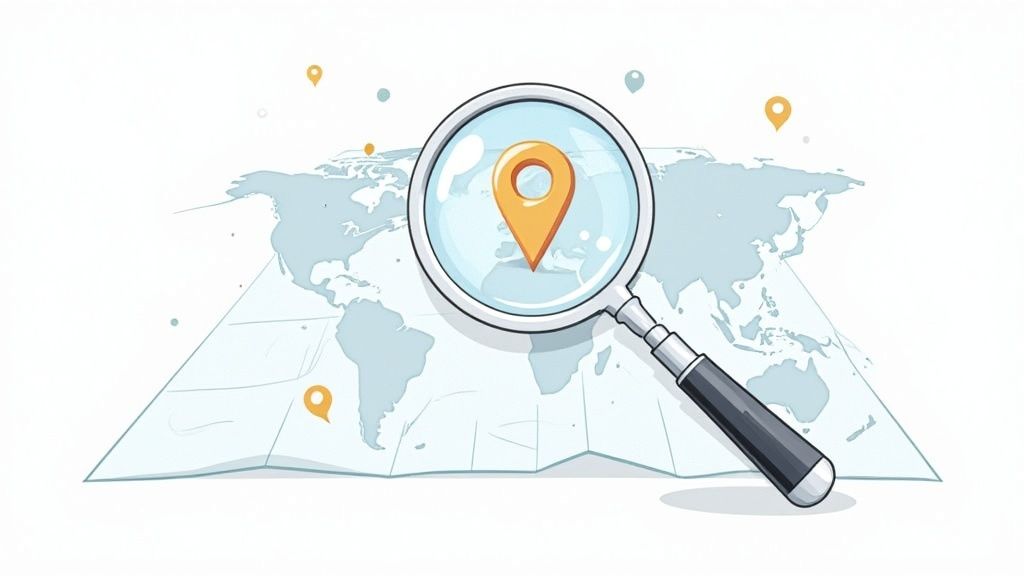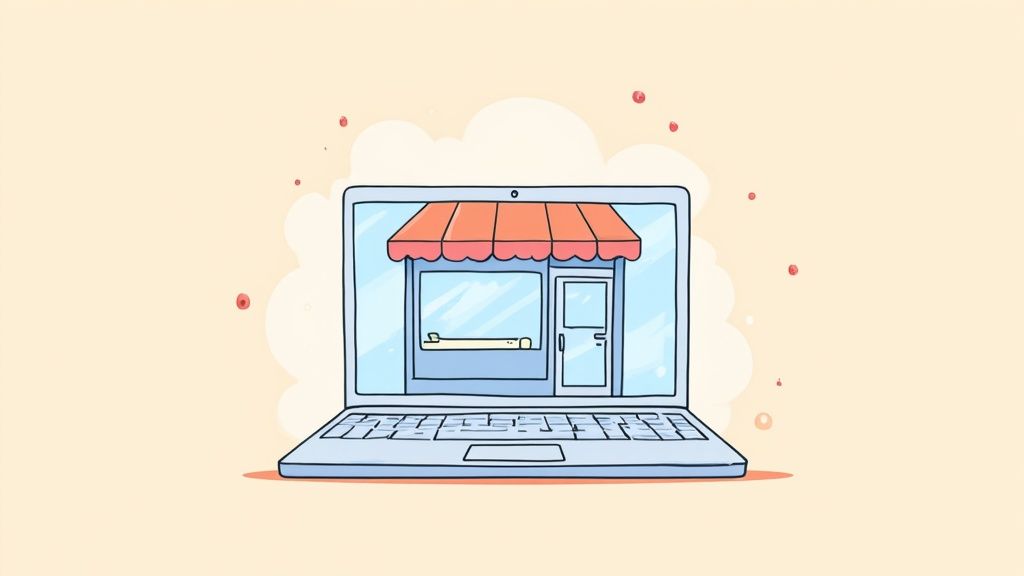So, you’re thinking about getting into the resale game. Smart move. It’s a booming world filled with passionate buyers and a real opportunity to build something special. But where do you actually begin? Getting started boils down to nailing four key things: figuring out your profitable niche, finding great stuff to sell, setting up your shop, and making those crucial first sales.
Think of this as your quick-start roadmap.
Your Resale Business Blueprint
This isn't some passing fad; it’s a real shift in how we shop. The beauty of reselling is that it's one of the most accessible ways to get into ecommerce. You don’t need a factory or a huge product development budget. You can build a legitimate business around things you genuinely find interesting, whether that's vintage band tees, rare mid-century glassware, or even refurbished tech.
One of the best parts? You don't need a huge pile of cash to start. I've seen countless successful resellers get off the ground with less than $100 and a smartphone. The secret is to smartly reinvest your first few profits right back into more inventory, letting the business essentially fund its own growth.
The Opportunity in Secondhand Goods
The energy behind the secondhand market is incredible right now. Just look at the numbers: the global secondhand apparel market is on track to hit a staggering $367 billion by 2029. The online part of that world is exploding, growing by 23% in 2024 alone—that's four times faster than traditional retail. It’s a clear signal that people are hungry for value, unique finds, and a more sustainable way to shop. You can dig deeper into these numbers in the full resale market report from thredUP.
The difference between a hobby and a business often comes down to having a plan. If you understand the core pillars from day one, you'll sidestep the common mistakes that trip up new sellers and build a business that's meant to last.
The Four Pillars of a Strong Start
Your journey from a spark of an idea to a running, profitable business can feel overwhelming, but it's really a series of manageable stages. When you focus on these foundations, you build on solid ground instead of getting lost in the weeds. Each piece naturally connects to the next, giving you a clear path forward.
- Finding Your Niche & Sourcing: This is the discovery phase. What will you sell, and where on earth will you find it? Success here is all about that sweet spot where your personal interests meet what people actually want to buy.
- Setting Up Shop: This is the "get official" part. Think business registration, bank accounts, and picking the right online platforms to sell your inventory.
- Listing & Selling: This is where the action happens. It's about taking amazing photos and writing descriptions that make people click "buy now."
- Growing & Scaling: Once the sales start coming in, the final piece of the puzzle is reinvesting your earnings to expand your operation.
To give you a bird's-eye view, I've broken down these foundational steps into a simple table. It’s a quick-reference roadmap for getting your venture off the ground.
Core Pillars of Your Resale Business Launch
This table summarizes the foundational steps required to get your resale business off the ground, providing a clear roadmap from concept to launch.
| Pillar | Key Actions | Why It Matters |
|---|---|---|
| Niche Selection | Identify a product category you're passionate and knowledgeable about. Research its market demand and competition. | A focused niche helps you build a brand, attract a loyal audience, and become a go-to expert. |
| Inventory Sourcing | Find reliable sources for inventory, such as thrift stores, estate sales, auctions, or wholesale suppliers. | Consistent access to high-quality, profitable inventory is the lifeblood of your resale business. |
| Business Setup | Register your business, open a separate bank account, and choose your selling platforms (e.g., eBay, Poshmark). | A proper legal and financial setup ensures you operate legitimately and makes tax time so much simpler. |
| Execution & Sales | Master product photography, write detailed descriptions, and manage your first sales, shipping, and customer service. | Strong execution turns inventory into profit and builds a positive reputation with your first customers. |
Getting these four pillars right from the start is what separates the flash-in-the-pan sellers from those who build sustainable, long-term businesses.
Finding Your Profitable Resale Niche

The most successful resellers I know don’t just sell things; they become known for something specific. It’s incredibly tempting to grab any item that looks like a bargain, but that scattergun approach rarely builds a business that lasts. If you want to succeed long-term, you need to find your profitable resale niche.
Think of it this way: a niche focuses all your efforts. It helps you become a genuine expert, build a brand people recognize, and attract a loyal following of customers who seek you out. This is how you go from being just another seller to becoming a destination.
Marrying Passion with Profit
The sweet spot for a great niche is where your personal interests, your existing knowledge, and real market demand all meet. Let's be honest, starting a resale business is hard work. Your passion is what will keep you going when you’re sorting through dusty boxes or packing orders late at night.
So, start by thinking about what you genuinely enjoy. Are you a lifelong gamer who can spot a rare Nintendo 64 cartridge from a mile away? Or maybe you have an eye for the clean, distinct lines of mid-century modern furniture. Tapping into that innate interest gives you a massive, built-in advantage.
Never underestimate the power of what you already know. The little details you understand—like the difference between a first-edition book and a later reprint—are what allow you to spot incredible value where others just see junk. This is your competitive edge, right from day one.
How to Analyze Market Demand
Of course, passion alone won't pay the bills. You have to confirm that people are actually willing to pay for the items you love. This is where a bit of practical research comes in—no fancy tools required, just some digital legwork.
- Study Sold Listings: Head over to platforms like eBay or Poshmark and search for items in your potential niche. The critical step here is to filter the results to show “Sold” or “Completed” listings. This reveals what people are actually buying and for how much, not just what sellers are asking.
- Gauge the Competition: Take a look at who else is selling in this space. A lot of sellers isn't always a bad thing; it proves there’s a market. Check out their listings. What are they doing well? More importantly, where are the gaps you could fill? Maybe their photos are dark, their shipping is overpriced, or their descriptions lack important details.
- Identify Trends: Are certain styles or brands suddenly popping up everywhere? Look for patterns. For instance, the recent resurgence of Y2K fashion has made things like vintage digital cameras and '90s brand-name clothing surprisingly profitable.
For a deeper look into specific hot categories, our guide on the best items to resell for profit can give you some excellent starting points for your research.
Test Your Niche with Low Risk
Once you've narrowed it down to a few ideas, it's time to test them without betting the farm. The goal here is simple: validate your niche with a small, low-risk experiment.
- Go on a Micro-Haul: Head to a thrift store or flea market with a clear mission. Give yourself a small budget—no more than $50-$100—to buy a handful of items that fit your chosen niche.
- List and Learn: Get those items photographed and listed. Now, pay close attention. How many views are the listings getting? Are you getting questions from potential buyers? Did anything sell right away, or did it just sit there for weeks?
- Analyze the Results: Even if you only break even on this first run, you’ve gained invaluable data. A quick sale at a healthy margin is a fantastic signal that you're onto something. If an item gets tons of views but no one bites, your price might be too high. If it gets no views at all, the demand may not be as strong as you thought.
This testing phase is where the theory ends and the real learning begins. It gives you the concrete, real-world feedback you need to build a business on a solid, profitable foundation.
Mastering Inventory Sourcing and Valuation

Let's be real: your ability to find great items is the engine of your entire resale business. You can have the best photos and marketing in the world, but if your products aren't desirable, you won't make a sale. Sourcing is a treasure hunt, and learning where to look—and what to look for—is the first real skill you need to master.
The most successful resellers I know never rely on just one spot. They build a whole network of places to find inventory, knowing that some days the thrift stores are goldmines and other days an obscure estate sale holds the real prize. This mix-and-match approach is your best defense against the inevitable dry spells and keeps your shop stocked with fresh finds.
Your Sourcing Battle Plan
Getting out there and finding things to sell is the most hands-on part of this business. Every sourcing spot has its own unique rhythm, and you'll need a slightly different strategy for each. Here are some of the most reliable places to kick off your hunt.
Thrift Stores
This is the classic training ground for a reason. Places like Goodwill and The Salvation Army get a constant flood of donations, which means their inventory changes almost daily. It's a numbers game.
- Go Often, and Go on Weekdays: Weekends are a madhouse with casual shoppers. I find that hitting the stores on a Tuesday or Wednesday morning often means I get first dibs on items that were just put out.
- Look Beyond the Obvious: Don’t just get tunnel vision on the clothing racks. Some of my best flips have come from the housewares, electronics, and even the book sections—places that many people breeze right past.
- Learn the Discount Days: Most big thrift chains have specific discount days, like 50% off all green-tagged items. Figure out the schedule for your local stores and plan your trips around it to stretch your budget.
Estate Sales and Auctions
This is where you graduate to finding higher-quality, often curated collections. An estate sale is literally a snapshot of someone's life, and you can find incredible things if you know what you're looking for.
Auctions, whether online or in-person, can feel a bit intense at first but give you access to really specialized stuff. The trick is to always preview the items beforehand and—this is crucial—set a hard budget for yourself. It's way too easy to get swept up in a bidding war and overpay.
Pro Tip: At an estate sale, especially on the last day, almost everything is negotiable. Don't be shy about bundling several items together and making a reasonable offer. By that point, the organizers are usually desperate to clear the house.
The Art of Smart Valuation
Finding an item is only half the battle. Knowing what it's actually worth is what separates a profitable business from a very expensive hobby. This is where you turn a good find into a great flip.
Your goal is to figure out the fair market value—not what you hope an item is worth, but what a real customer is willing to pay for it today. This takes a little detective work.
Start by searching for your item on a marketplace like eBay, but immediately filter your search to show “Sold Listings.” This is the single most important piece of data you can find. It shows you the actual prices that real buyers have paid recently. An active listing only shows what a seller is asking, which is often pure fantasy.
Once you see a range of sold prices, you need to be brutally honest about your item's condition. A tiny chip, a faint stain, or a missing remote can slash the final value. Compare your item to the ones that have sold to see where it truly stacks up.
For those unique or antique pieces where finding a direct comparison is tough, pricing can feel like a guessing game. If you're stuck, our guide on how to find the value of antiques dives into some more advanced techniques.
Remember, what you pay for an item directly controls your profit margin. A great rule of thumb is the 1/3 Rule: aim to buy an item for one-third of what you think you can sell it for. This leaves one-third for platform fees and shipping, and a final third for your profit. You won't hit it every time, but it’s the perfect target to keep in mind when you're out sourcing. It keeps you honest and makes sure your efforts are actually paying off.
Setting Up Your Business The Right Way

Finding that perfect piece of inventory is the thrill of the hunt, but handling the paperwork is what turns a fun hobby into a legitimate business. I get it—thinking about legal structures and bank accounts can feel daunting. But getting this stuff right from the very beginning is one of the smartest things you can do. It protects you personally, makes your finances a thousand times easier to manage, and builds a solid foundation for growth.
This isn't about becoming a lawyer overnight. It’s about taking a few crucial steps to run your operation confidently and avoid massive headaches later, especially when tax season rolls around.
Choosing Your Business Structure
Your first real "business" decision is picking a legal structure. For most people starting out in resale, it really boils down to two options: a sole proprietorship or a Limited Liability Company (LLC).
A sole proprietorship is the simplest path. In fact, it's the default. If you start selling things for profit and don't formally register as anything else, congratulations—you're a sole proprietor. It's easy because you don't have to do anything, and you just report your business income on your personal tax return. The big downside, however, is that there’s no legal separation between you and the business. This means if your business gets into debt or faces legal trouble, your personal assets (like your home or car) could be on the line.
An LLC, on the other hand, gives you a vital shield of protection. It establishes your business as a separate legal entity, which protects your personal assets from any business liabilities. Yes, it takes a little more paperwork and a state registration fee, but that peace of mind is worth its weight in gold as you grow. If you're serious about this, forming an LLC is a sound investment in your own financial security.
A lot of successful resellers I know started out as sole proprietors just to test the waters. Once they saw the sales were consistent and they were ready to go all-in, they made the switch to an LLC. It’s a very common and practical way to ease into it.
Getting Official With Banking and Registration
Once your structure is sorted, a few more steps are non-negotiable for running a clean operation. These tasks draw a clear, bright line between your personal life and your business—something your future self (and your accountant) will thank you for.
- Register Your Business Name: You'll likely want to operate under a cool brand name instead of your own legal name. To do that, you may need to file a "Doing Business As" (DBA) name with your state or county.
- Open a Dedicated Business Bank Account: Please, do not skip this. Co-mingling your business and personal funds is a recipe for an accounting nightmare. A separate business account makes it incredibly easy to see your actual profit and loss and keeps your records tidy for the IRS.
- Get a Handle on Sales Tax: You will almost certainly need a resale permit (sometimes called a seller's permit) from your state's tax agency. This is a golden ticket that lets you buy inventory for resale without paying sales tax on it. The flip side is you'll be responsible for collecting sales tax from your buyers and sending it to the state.
Tracking Income for Profit and Taxes
Knowing your numbers is everything. If you don't track what's coming in and what's going out, you're just guessing at your profitability.
You don't need fancy software at first; a simple spreadsheet can do the trick. Just be meticulous. Keep records of what you paid for every item, shipping supply costs, marketplace fees, and every single sale. This data is not only for tax time—it’s intel that shows you which products are your real money-makers. Knowing your costs is also fundamental to pricing your inventory correctly, a skill you can sharpen by learning how to price estate sale items and other one-of-a-kind finds.
Creating Listings That Convert

Finding incredible inventory is only half the battle. Let's be real—amazing items won’t just sell themselves. Your product listings do all the heavy lifting, acting as your silent salesperson, working 24/7 to turn a casual browser into a confident buyer.
Think of each listing as its own mini sales page. It has to grab attention, build trust, answer questions, and ultimately make someone feel good about clicking "add to cart." This is where you get to blend the art of storytelling with the science of a great sales pitch.
Master Your Product Photography
In the world of online resale, your photos are everything. They're the first—and sometimes only—thing a potential buyer sees. Dark, blurry, or cluttered photos scream "amateur" and can kill a sale before it even gets started.
Good news: you don't need a fancy DSLR camera. Your smartphone is more than capable. The real secret comes down to two things: lighting and a clean background.
- Natural Light is Your Best Friend: Always try to shoot near a window during the day. That soft, indirect sunlight makes colors look true to life and gets rid of those ugly, harsh shadows.
- Keep the Backdrop Simple: A plain white or neutral-colored wall works wonders. You can also grab a large sheet of poster board from a dollar store or just use a clean, ironed bedsheet.
- Show Every Single Angle: Take way more photos than you think you need. I'm talking front, back, sides, top, and bottom. Then, zoom in for close-ups of any important details like brand tags, unique textures, or specific features.
Most importantly, be completely transparent. If there's a flaw—a tiny chip, a faint stain, or a scratch—take a clear, well-lit photo of it. Point it out. I know it feels weird to highlight the bad stuff, but it builds a massive amount of trust and dramatically reduces the chance of a return or a negative review.
Write Titles and Descriptions That Actually Sell
Once your photos have grabbed their attention, your words have to close the deal. A well-written title and description don't just provide information; they're critical for helping your item get discovered in a crowded marketplace.
Think of your title as your most valuable piece of real estate. You need to pack it with the keywords a real person would actually use to find your item. Put yourself in their shoes—what would they type into the search bar?
A proven formula for a great title is: Brand + Product Name + Key Features + Size/Color/Style.
For instance, instead of "Cool Vintage Shirt," a much stronger title would be something like: "Vintage 90s Nike Windbreaker Jacket Mens Large Blue & Green Colorblock." See the difference?
Your description then needs to expand on that title, answering any potential questions before they even have to ask.
- Measurements are a Must: For clothing, always include key measurements like pit-to-pit, length, and inseam. For hard goods, provide the height, width, and depth. Don't make them guess.
- Describe the Condition Honestly: Use simple, direct terms like "Excellent Used Condition" or "Good Condition with minor wear." Then, describe exactly what that wear is.
- Tell a Quick Story: If you know anything about the item's history or what makes it special, add a sentence or two. It adds personality and can really boost its perceived value.
The online resale market is booming. In 2024, it generated $16.8 billion in the U.S. alone. While 38% of online shoppers have bought secondhand items, a massive 62% have yet to try it. The key to winning over this huge, untapped market is building trust through crystal-clear listings that remove all doubt. You can dive into more thrifting statistics and see the full scope of the resale opportunity.
Be Radically Transparent About Flaws
One of the biggest fears for any online buyer is receiving an item that isn't as described. The single best way to overcome this is to be radically transparent about every single imperfection, no matter how small you think it is.
It’s tempting to downplay flaws or hope nobody notices, but this approach almost always backfires. A seller who points out a small issue is seen as trustworthy. A seller who tries to hide it is seen as dishonest, even if the rest of the item is perfect.
When you describe flaws, be specific and unemotional.
- Don't say: "Slightly damaged"
- Instead, try: "There is a small 1-inch scratch on the front left side, as shown in the final photo."
This level of honesty builds incredible credibility. It signals to the buyer that you’ve thoroughly inspected the item and are presenting it accurately. A customer who buys an item knowing its exact condition is almost always a happy customer, and this simple practice will save you countless headaches from returns and disputes down the road.
Answering Your Top Reselling Questions
As you get ready to dive in, you're bound to have questions. It’s completely normal. Getting solid answers to these early questions can make all the difference, giving you the confidence to get started and push through the inevitable learning curve. Let's tackle some of the most common ones I hear from new sellers.
How Much Money Do I Really Need to Start?
Forget the myth that you need a huge pile of cash to start a business. With reselling, that's just not the case. You can absolutely get started with a very small amount of capital—often as little as $50 to $100. That's just enough to cover your first handful of items.
The secret to growing from there is all about smart reinvestment. In the beginning, don't even think about paying yourself. Your goal is to pour every dollar of profit from your initial sales right back into buying more inventory. This disciplined approach lets your business fund its own growth. That first $50 can quickly become a self-sustaining operation without you having to dig back into your own pocket. My advice? Avoid any big, risky buys until you have a real feel for what actually sells.
The beauty of this model is how little risk is involved at the start. Your first "inventory haul" doesn't need to be huge. Think of it as a small, low-cost experiment to test your niche and get comfortable with listing and shipping.
Which Platform Is Best for Selling?
There’s no single "best" platform—it all comes down to what you’re selling. The key is to match your products with the platform where your ideal customers are already shopping. Putting your stuff in front of the right eyeballs is half the battle.
Here’s a quick rundown of where different items shine:
- eBay is still the king for collectibles, vintage treasures, car parts, and electronics. Its huge audience and auction-style option make it perfect for one-of-a-kind finds.
- Poshmark and Depop are the go-to spots for fashion. Poshmark is great for trendy, well-known brands, while Depop caters to a younger crowd looking for unique vintage and streetwear.
- Facebook Marketplace is your best friend for local sales, especially for big or bulky things like furniture. Selling locally lets you skip the headache and cost of shipping altogether.
A word of caution: don’t try to be everywhere at once. Pick one or two platforms that feel right for your items and learn them inside and out before you even think about expanding.
How Do I Handle Shipping and Returns?
Shipping can feel like a huge hurdle, but it's easy to manage once you have a system. First things first, buy a small digital scale and a measuring tape. You absolutely need these to calculate accurate shipping costs and avoid losing your profits to unexpected postage fees.
Always use the shipping labels provided through the marketplace itself, whether it's eBay, Poshmark, or another platform. They offer commercial discounts you simply can't get walking into the post office. To keep your supply costs near zero at the start, just save the boxes, bubble wrap, and packing paper from your own online purchases.
When it comes to your return policy, keep it simple. Many new resellers start with a "no returns" policy just to avoid the hassle. That's perfectly fine. But it's worth knowing that offering a 30-day return policy can really boost a buyer's confidence and might lead to more sales, as it takes the risk off their shoulders.
Ready to turn your interesting finds into profitable flips? Curio is the perfect tool for any reseller looking to quickly understand the value and history of an item with just a photo. Stop guessing and start knowing. Download Curio and get your first appraisal on us!
